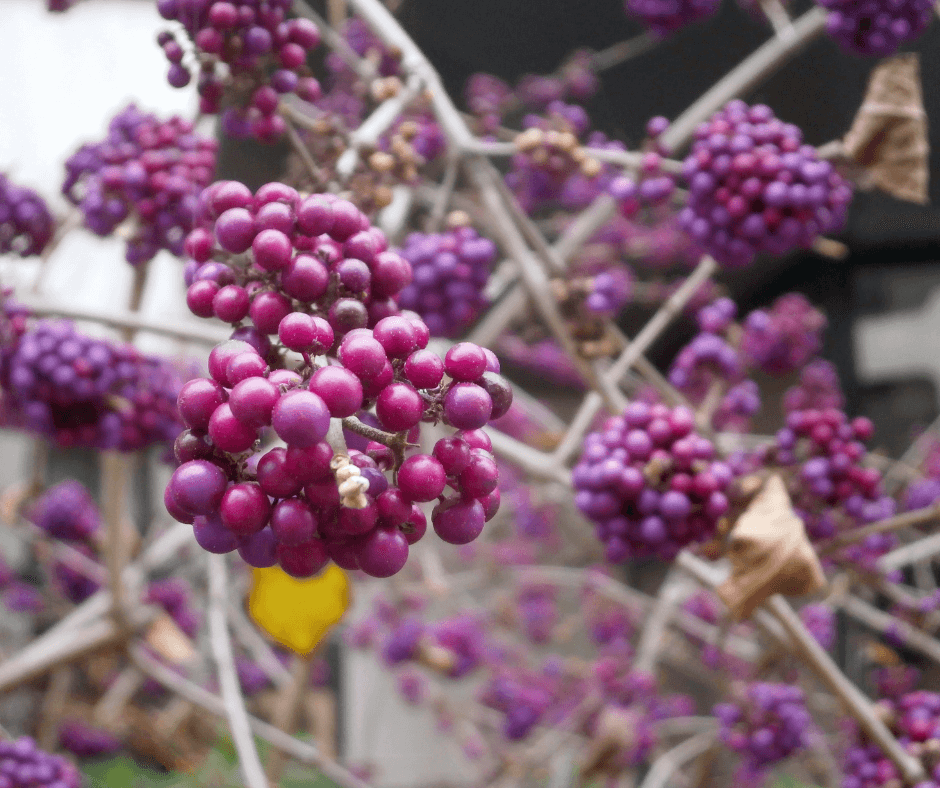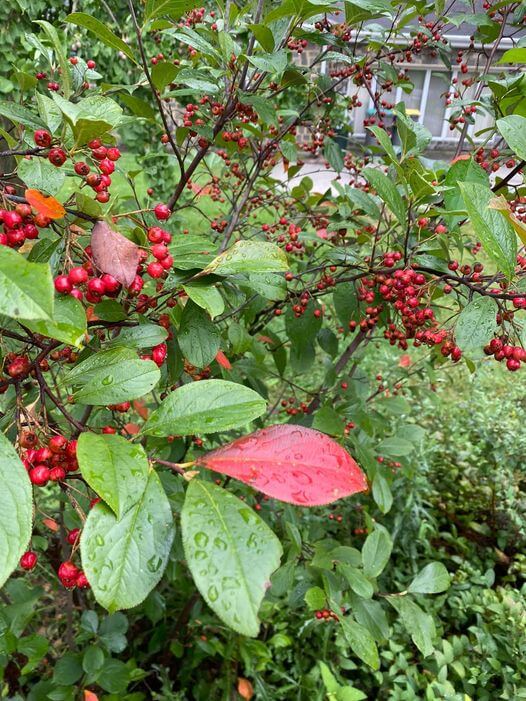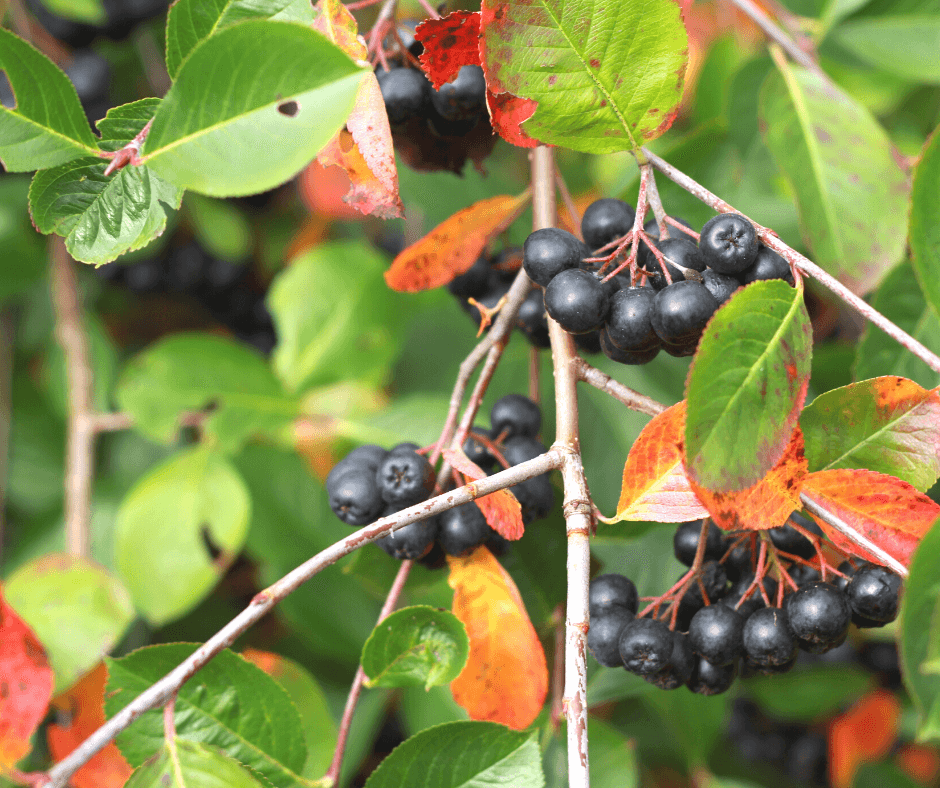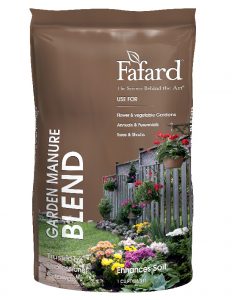
Depending on where you live, October can be a time when the last of the late summer and early fall color is fading from the garden. The asters are almost finished, the goldenrod is going, and most of the color comes from potted mums and Halloween pumpkins.
But your landscape does not have to succumb to drabness. There is an answer to the color dilemma—shrubs and trees with eye-catching fruits or berries. Taking center stage with gem-like red, black, purple, or yellow fruit, these plants multi-task by beautifying the garden while providing food for birds and small animals. The following species and varieties are among the best investments for the four-season landscape.
Passionate Purple Beautyberry

Beautyberry (Callicarpa ssp.) more than lives up to its name, with clusters of vivid purple berries hugging the stems, which also bear ovoid, slightly toothed green leaves. A member of the Lamiaceae or mint family, deciduous beautyberry boasts bronze spring foliage, small pink summer flowers, and fall berries–all on graceful, arching stems. There are several species of beautyberry available commercially. Among the most popular is ‘Profusion’; a variety of Bodinier’s beautyberry (Callicarpa bodinieri), which is celebrated for its heavy crops of fall berries. Hardy in USDA Hardiness Zones 5 through 8, ‘Profusions’ grows 4 to 6 feet tall and wide, perfect for use as a specimen plant, an anchor in a large garden bed, or en masse to form a noteworthy hedge. Other available species include native American beautyberry (Callicarpa americana), which is slightly more heat-tolerant than other species and hardy in zones 6 through 10; the slightly smaller purple beautyberry (Callicarpa dichotoma), hardy in zones 5 through 8; and Japanese beautyberry (Callicarpa japonica), hardy in the same USDA Hardiness Zones. All will thrive in full sun to light shade and can withstand clay soil. They should be pruned back in late winter for health and appearance’s sake.
A Non-Traditional American Cranberry

The universe of beautiful viburnums is large, but highbush cranberry, also known as cranberry viburnum or American cranberry (Viburnum opulus var. americanum), is one of the loveliest in autumn. It is not a true cranberry but bears edible fall fruit in a brilliant shade of red. As the name suggests, highbush cranberry is native to North America and grows large—8 to 12 feet tall and wide—but delivers a lot in return for that significant investment of garden space. In spring the shrubs sport flat-topped flower clusters reminiscent of Queen Anne’s lace, followed by dark green leaves, with three lobes apiece and an appearance akin to maple foliage. The leaves sometimes color up in fall before disappearing, but the crimson berries tend to outshine them.
Highbush cranberry is hardy in zones 2 through 7, performs well in full sun to light shade, and can survive cold winters. The flowers are beloved by butterflies and the fruits are attractive to birds. Humans can use them in much the same way as true cranberries—in jams, jellies, and confections.
Golden Crabapples

All flowering crabapple trees (Malus spp.) are beautiful, and, at anywhere from 6 to 20 feet tall, depending on variety, compact enough for many home landscapes. They flower in spring in a frothy burst of pink buds that open to pink or white blossoms, with single or double rows of petals. Some never fruit, but many crown the fall season with small round apples in shades of pink to rosy red. The much-loved Sargeant crabapple (Malus sargentii), is a dwarf variety that can be grown as a large shrub or standardized as a small tree, is one of the red-fruited varieties. It is hardy in zones 4 through 7.
Red is heartening, but yellow or gold-fruited crabapples are especially dramatic. Cultivars like the rosy gold fruits of ‘Golden Harvest’, clear golden yellow fruits of ‘Golden Raindrops‘, and the larger, edible, golden crabapples of ‘Golden Hornet’, which is also a Royal Horticultural Society award winner. All are hardy to zones 4 through 8 and produce abundant, showy fruits that are beloved of birds and humans.
Crabapple fruits are not as persistent as some fall berries but are beautiful while they last. Many varieties also feature leaves that color up in the fall, prolonging the brilliant show.
Flowering crabs are tolerant trees, able to flourish in clay soil and withstand drought, once established in sunny locations. Prune to shape in late winter.
Brilliant Chokeberry

Chokeberry is an unattractive name for a very attractive, deciduous flowering and fruiting shrub. Aronia melanocarpa, known as black chokeberry, is the most common chokeberry in commerce. A member of the rose or Rosaceae family, black chokeberry is native to the eastern half of North America and is hardy in zones 3 through 8.
In the spring, the shrub starts with small clusters of five-petaled white flowers, which lure bees and other pollinators. These give way to glossy black fruits in the fall. If the birds do not get them all, the fruits may persist after frost. Though edible, they are sour but can be cooked and sweetened to make jellies, relishes, and other dishes. Chokeberry fruits share the spotlight with the leaves, which turn red-purple in fall before dropping from the plants. Black chokeberry is the smallest of the Aronia species at three to six feet tall and wide.

Chokeberry lovers who crave red fruits can invest in Aronia arbutifolia or red chokeberry, which grows 6 to 10 feet tall and 3 to 6 feet wide and is hardy in USDA Hardiness Zones 6 through 9. A slightly more cold-hardy black chokeberry/red chokeberry hybrid, Aronia x prunifolia produces dark purple fruits on shrubs that grow 8 to twelve feet tall and 6 to 9 feet wide. It is hardy in USDA zones 4 through 7.
Chokeberries are suckering shrubs that can form thickets if left untended. They crave consistent moisture and are happy in moist or even swampy spots, including pond or stream edges.
Giving Fruiting Trees and Shrubs a Good Start
Beautyberry, highbush cranberry, crabapple, and chokeberry are relatively unfussy plants but benefit from a good start. Site in sunny locations and amend the soil at planting time with nutritious Fafard Garden Manure Blend. Water regularly to establish root systems, and keep chokeberries irrigated during dry spells. (Click here for a full guide to properly siting and planting shrubs and trees.)

